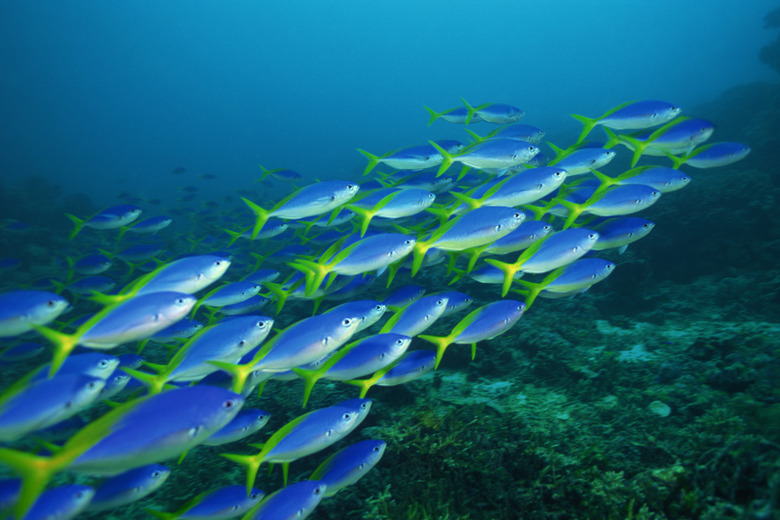What Is The Major Primary Producer In The Marine Ecosystem?
At the base of every food chain lie primary producers: organisms that turn sunlight into chemical energy and later become food for consumers that can't manufacture their own. The major primary producers in most marine ecosystems are microscopic plankton, tiny green photosynthesizers floating in the ocean's sunlit upper layers. What plankton lack in size they make up for in numbers; small as they seem, these tiny creatures sustain some of the largest animals on the planet.
TL;DR (Too Long; Didn't Read)
A very diverse group of microorganisms known as phytoplankton perform the essential role of primary producers in the oceans, turning sunlight into usable chemical energy and thereby forming the base of the marine food chain.
Phytoplankton & the Marine Food Chain
Phytoplankton serve as the major primary producers in the marine ecosystem. These microscopic, single-celled plants, bacteria, algae and other organisms harvest sunlight through photosynthesis and store it as chemical energy before becoming food for tiny creatures called zooplankton. The zooplankton fall prey to larger animals like small fish and jellyfish, and these in turn become meals for larger fish, squids, sharks and marine mammals. The phytoplankton rest at the base of these food chains because all the energy used by these larger organisms comes from them.
Types of Phytoplankton
Phytoplankton fall into a number of major categories including diatoms, dinoflagellates, coccolithophores and picoplankton or cyanobacteria. All of these except cyanobacteria are eukaryotes, cells with a nucleus. Single-celled dinoflagellates use whiplike tails called flagella to push themselves through the water like tiny propellers. Coccolithophores sport tiny armorlike plates that make up their microscopic cell walls. These plates are formed from calcium carbonate – the same stuff that composes limestone and chalk. Indeed, large chalk deposits such as those found at the Cliffs of Dover in England derive from accumulated coccolithophore shells.
Diatoms: Photosynthetic Powerhouses
Diatoms are an especially important class of phytoplankton because they account for as much as 60 percent of primary productivity in the marine ecosystem and perhaps some 20 percent of the total photosynthesis on Earth. Like dinoflagellates and coccolithophores, they are single-celled. Their most distinctive feature is their cell wall, which is made from silica, the same material from which glass and sand are made. There are perhaps as many as 200,000 different species.
Cyanobacteria: More Photosynthetic Powerhouses
Cyanobacteria play a huge but ill-understood role as phytoplankton in the marine ecosystem. Scientists estimate there are at least 100 million times more bacteria in the world's oceans than there are stars in the sky. Ocean cyanobacteria account for perhaps as much as a quarter of all photosynthesis on Earth. These organisms are very difficult to research because most of them have never been grown in culture and thus cannot be directly studied in the lab. Many of them furnish nutrients for other organisms or enter the food chain directly by becoming food for zooplankton.
Cite This Article
MLA
Brennan, John. "What Is The Major Primary Producer In The Marine Ecosystem?" sciencing.com, https://www.sciencing.com/major-primary-producer-marine-ecosystem-4683/. 30 April 2018.
APA
Brennan, John. (2018, April 30). What Is The Major Primary Producer In The Marine Ecosystem?. sciencing.com. Retrieved from https://www.sciencing.com/major-primary-producer-marine-ecosystem-4683/
Chicago
Brennan, John. What Is The Major Primary Producer In The Marine Ecosystem? last modified March 24, 2022. https://www.sciencing.com/major-primary-producer-marine-ecosystem-4683/
